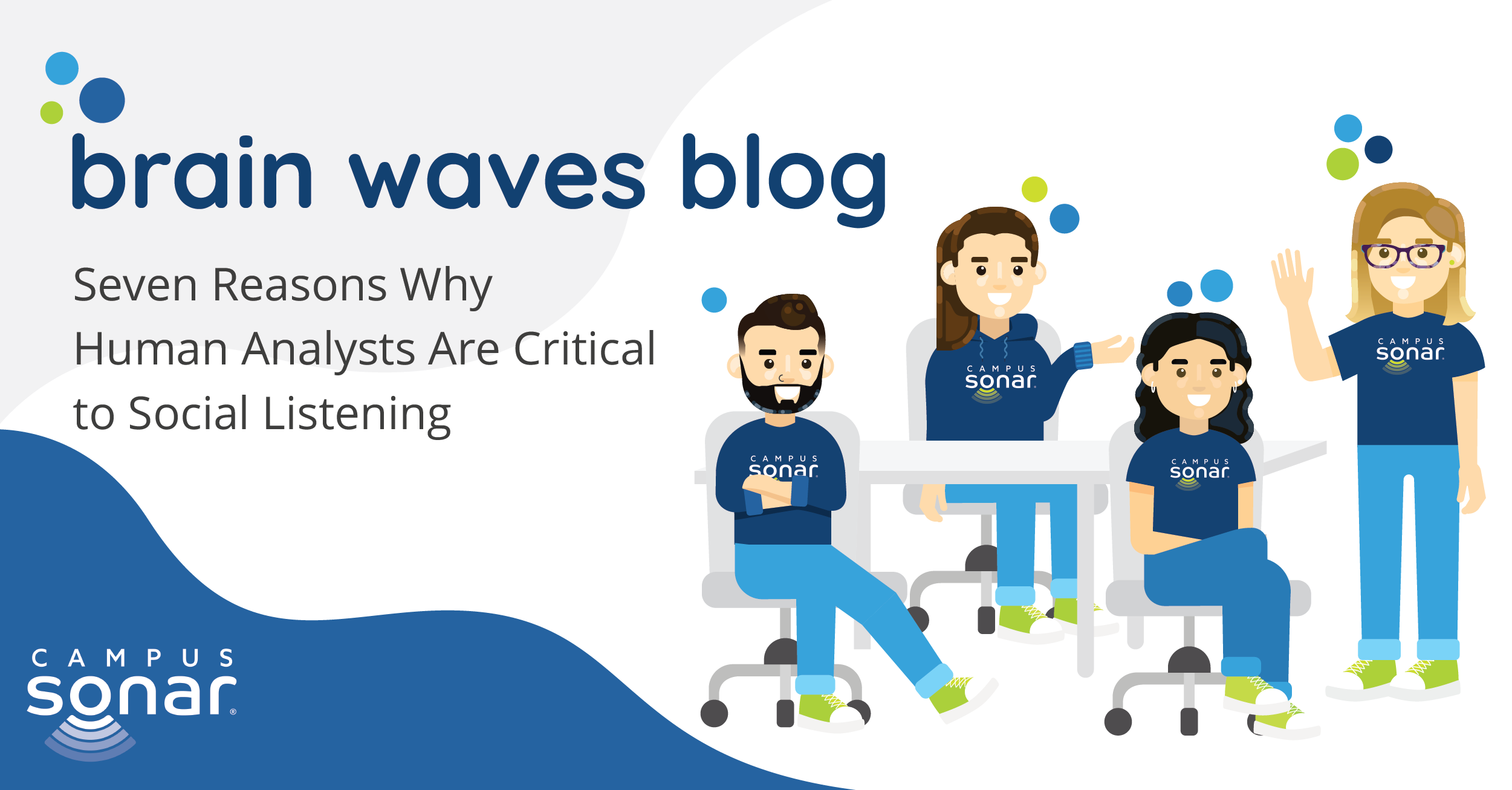Seven Reasons Why Human Analysts Are Critical to Social Listening

Over the last few years, social listening software has become increasingly popular for higher ed martech stacks. But something we hear often from our clients is that marketing teams struggle to get the full value from expensive software. Lack of time, training, and ability to pull readily usable data are common struggles.
But software is only as valuable as the time you’re able to spend on it. And this is where the value of a human analyst comes in. Whether this is a position you can hire onto your team or you partner with us at Campus Sonar, here are the top seven reasons why human analysts are critical to performing relevant and strategic social listening, based on the expert work our own analysts perform daily.
- Humans understand sarcasm. The days of blue text and /s are over. Unless you’re personally familiar with an individual or organization, it can be difficult to discern sarcasm online and appropriately diagnose the sentiment of online conversation. A human analyst takes the time to use context clues to dig into the online persona of an individual or organization generating content to better understand if a mention is sarcastic or not.
- Humans can always dig deeper. The skill required to piece together online evidence to identify rogue social media account admins or mystery Reddit authors is second-to-none for our analysts. Like detectives, they look across the internet for clues, and many times surprise their clients with their in-depth knowledge of campus who’s-who and goings-on.
- Humans ensure greater relevancy. Does your campus use an acronym? Share your name with other campuses? You’re not alone—many higher ed campuses share their name with non-higher ed entities. A human analyst surveys the landscape and discovers these interlopers, making a series of analytical choices to determine how to capture the online mentions that do relate to the right campus while excluding those that don’t. This also means that a human reviews the majority—or a representative sample—of online mentions and ensures the validity of the dataset.
- Humans are better at adding context. A machine may just give you numbers. A human analyst gives you sweet, sweet context. For example, we’re able to tell our clients how their online conversation metrics shape up when compared to the higher ed industry, their competitors, and their past performance. Analysts are experts at analyzing changes over time in online conversation, and finding out what may cause those changes or what changes correlate within your data.
- Humans help identify real crises. Things go viral on the internet. An algorithm may tell you that your online conversation has changed drastically, but a human analyst? They’ll let you know the sentiment around that change in conversation, assess top conversation themes, understand the audience contributing to that conversation, and provide information on who’s influencing that conversation and where. The difference between a human analyst and a machine in this case might just be the difference between a panicked statement and strategizing with the information you need in hand.
- Humans are better at nuance than software. Often, reporting on social listening trends comes down to comparing segments like audience, conversation topics, or content type. Human analysts care a lot about not only how they create segments within their dataset, but also how they define those segments. When a human analyst considers how to define segments, they think about whether to base the definition on intent, impact, keywords, or—more often than not—a combination of all three. You’d better believe that a human analyst reporting on a client’s brand attribute conversation feels confident in their segmentation creation and definition—and because of that their client’s report is much more accurate.
- Humans ensure data is tied to outcomes. Sure, advanced software can offer insight into what people say, how they feel, and where they share online. But data without analysis for meaning and action is just words and numbers. A human analyst is equipped to triangulate between a campus’s specific goals, finding meaning behind the data, and working with others to identify actionable recommendations.
We could go on. But at the end of the day, the most important thing to understand about software vs. humans is that each separately is only as good as what is put into an effort. If you only put two keywords into a software query, you’re only getting data back on those two keywords, and it may not even all be relevant. If an analyst only has an hour a day for social listening, no matter how skilled they are, you’re only going to get an hour’s worth of analysis each day, which may drastically impact the success or timeliness of an initiative. But combine the two with the time and space to do the work and you get the power of machine plus the human brain with all of its learned expertise.
And when you partner with an agency like Campus Sonar who does everything for you, that power fuels your initiatives, leaving you to focus on turning strategy into action.
If you want to know more about what it's like to work with Sonarians, hear what our clients have to say. They give you the lowdown on what life is like with Campus Sonar.

